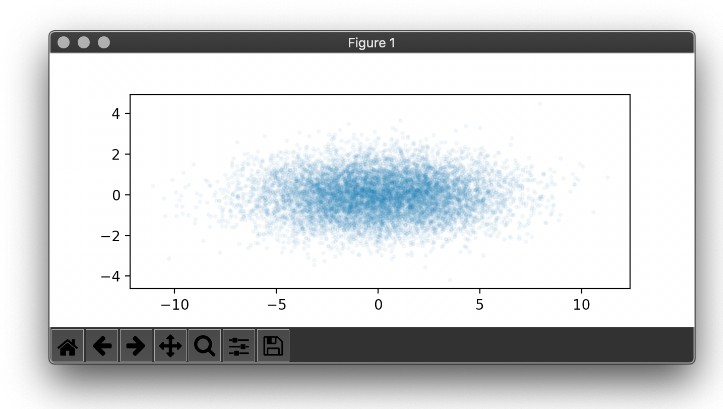PySvelte
THIS LIBRARY IS TOTALLY UNSUPPORTED. IT IS PROVIDED AS IS, AS AN EXAMPLE OF ONE WAY TO SOLVE A PROBLEM. MANY FEATURES WILL NOT WORK WITHOUT YOU WRITING YOUR OWN config.py FILE.
If we want to understand neural networks, it’s essential that we have effective ways of getting lots of information from the innards of those models into a readable form. Often, this will be a data visualization.
Unfortunately, there’s an awkward mismatch between workflows for deep learning research and data visualization. The vast majority of deep learning research is done in Python, where sophisticated libraries make it easy to express neural networks and train them in distributed setups with hardware accelerators. Meanwhile, web standards (HTML/Javascript/CSS) provide a rich environment for data visualization. Trying to use Javascript to train models, or Python for data visualization, takes on a very significant handicap. One wants to use the best tools for each task. But simultaneously working in two ecosystems can also be very challenging.
This library is an attempt at bridging these ecosystems. It encourages a very opinionated workflow of how to integrate visualization into the deep learning research workflow. Our design goals include:
- To make it easy to create bespoke, custom visualizations based on web standards and Svelte, and use them in Python.
- To encourage visualizations to be modular and reusable.
- To make it easy to publish persistent visualizations to standalone, sharable pages.
- To allow researchers who don’t know anything about web technologies to use visualizations their colleagues create.
Set Up
Many features in this library (such as publishing visualiations to GCS/S3/AZ buckets), require you to write several functions specific to your own research setup in config.py.
Basic use
The basic idea is that we create a Svelte component inside the src/ folder, say src/Hello.svelte:
<script>
export let name;
</script>
<h2>Hello {name}!</h2>
This visualization automatically becomes available in Python as pysvelte.Hello(). This includes tab completion for argument names.
We can now use it as follows.
import pysvelte
pysvelte.Hello(name="World")
(A few details: (1) This should work without directly running any npm build process; pysvelte will trigger necessary builds for you from Python, in order to make visualizations easily usable by those without web expertise. (2) Argument names are mandatory, since mapping argument names based on order would be very fragile as the svelte component is edited. (3) In addition to objects with clear javascript analogues, NumPy arrays can be passed into components and will be exposed on the javascript side as SciJs NdArrays.)
In a jupyter or colab notebook, the visualization should automatically display if its the last thing computed in a cell. One can also use .show() to show items that aren’t the last line:
pysvelte.Hello(name="Alice").show()
pysvelte.Hello(name="Bob").show()
Once you configure config.py you should also be able to use .publish() to publish your visualizations and easily share them. By default, new published visualizations can also be shared on slack to make it easier for your colleagues to discover them, and for convenient sharing when pair programming.
pysvelte.Hello(name="World").publish("~~/hello_world.html")
The objects returned when you use a component are pysvelte.Html() objects, which can be added together. This is useful to create pages.
html = pysvelte.Html("<h1>My Hellos Page</h1>")
html += pysvelte.Hello(name="Alice")
html += pysvelte.Hello(name="Bob")
html.publish("~~/hellos.html")
One final feature we want to highlight is that Svelte components can have companion Python files, like this src/Hello.py. This can be used to add doc strings (which appear in tab completion), argument type signatures, do Python-side validation of data for easier debugging, and even modify data before it is passed to Javascript.
def init(name: str):
"""A visualization which says hello to a given name."""
assert len(name) > 0, "Name can not be empty."
assert name[0] == name[0].upper(), "Name must be capitalized."
Example component
src/AttentionMulti.svelte contains an example of a component we’ve
developed internally which we use to to visualize attention patterns
from Transformer self-attention blocks. You can view a rendered
version of (a variant of) this
component
in our recent paper.
See src/AttentionMulti.py for documentation.
Learn More
On the javascript side, the major things to understand are:
D3 is also helpful!
License
Copyright 2021 Anthropic
Licensed under the Apache License, Version 2.0 (the “License”);
you may not use this file except in compliance with the License.
You may obtain a copy of the License at
http://www.apache.org/licenses/LICENSE-2.0
Unless required by applicable law or agreed to in writing, software
distributed under the License is distributed on an “AS IS” BASIS,
WITHOUT WARRANTIES OR CONDITIONS OF ANY KIND, either express or implied.
See the License for the specific language governing permissions and
limitations under the License.





